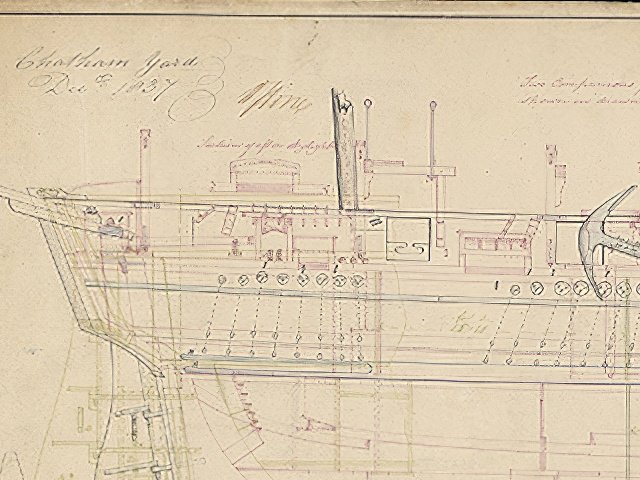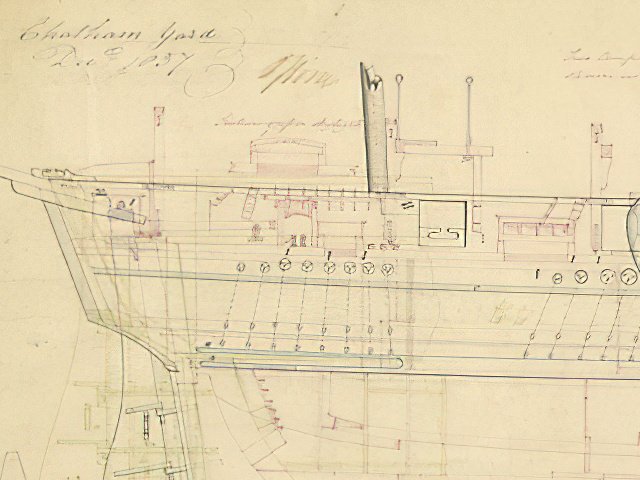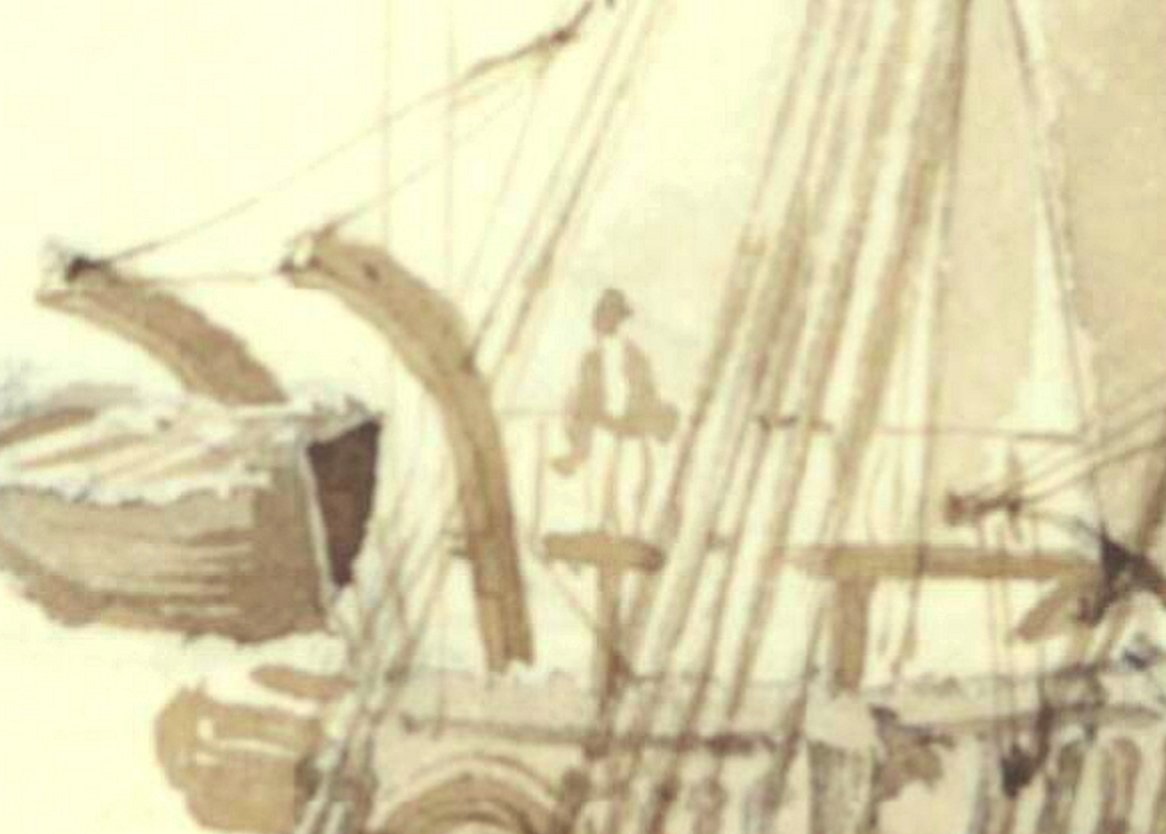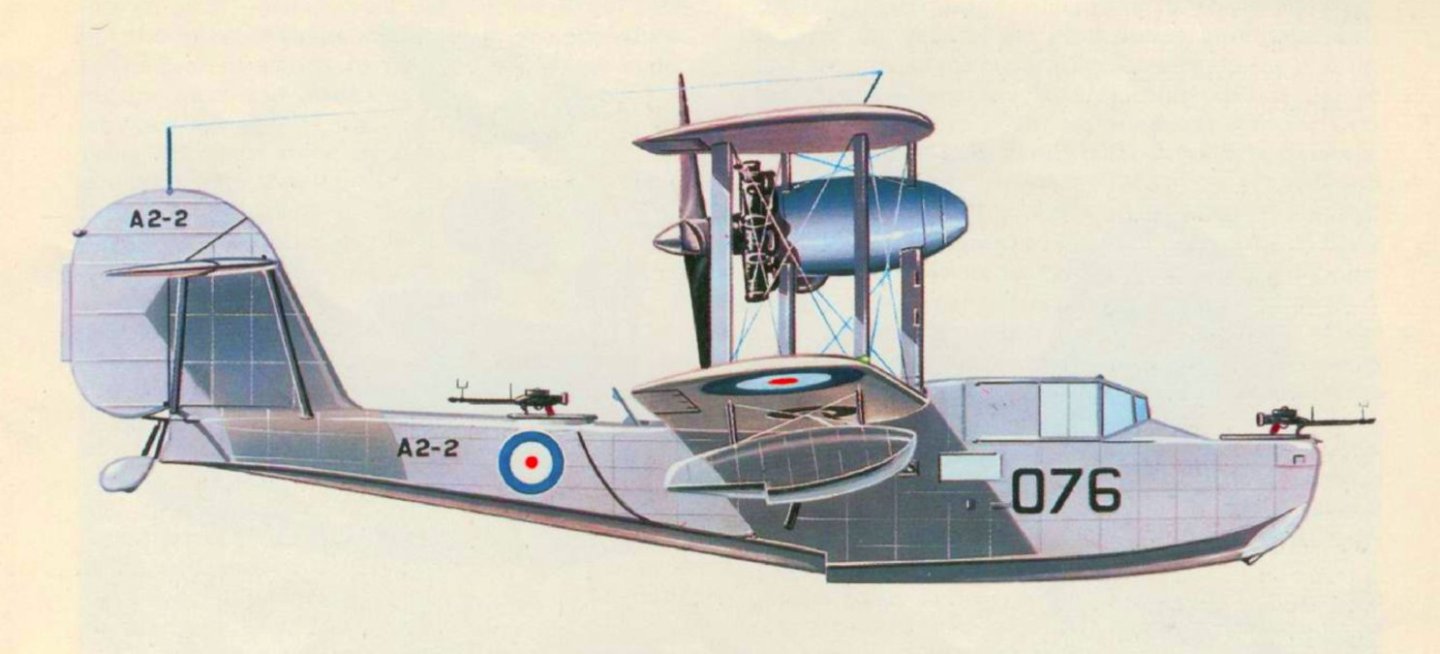-
Posts
976 -
Joined
-
Last visited
Content Type
Profiles
Forums
Gallery
Events
Everything posted by iMustBeCrazy
-
Well, it seems I have been rather lacking, I have been limiting myself to those lovely high resolution scans from wiki commons and ignoring the low res ones at the RMG. Specifically ZAZ5672 of which there are two versions, the first shows the bridge details in red the second in black which leads me to think it depicts section A-A (or thereabouts) below.
-
Kieth, first thing to remember is it's an artists impression, useful for things like curved davits, the face the bridge existed and some details like the halliards. But the davits are shown as inside the bulwarks when we're pretty sure they were outside and the davits are way out of proportion, the skid beams and post don't seem to be shown but perhaps two support posts for the bridge are? Perhaps they removed the skids and used the to operate the davits? I agree with iron stanchions with rope handrails (that's what I tried to depict above) but how many to provide support, you could tension the rope better if you had a diagonal support at the outer posts which would need less stanchions. Anyway, here's an enlargement of the drawing:
-
I've also been playing with the bridge, it doesn't really work but I thought I'd open it up for discussion.
-
It seems to be more an issue with the kit, for it all to fit as drawn the aft side of the skid beam should almost touch the mast. I'm not sure what exactly the cause is, perhaps slightly oversize deadeyes? I would probably shave off a few half millimeters where I could, notch the davit post so the skid beam fits flush, shave half millimeter off the skid beam, notch the skid beam another half millimeter where it meets the davit post, shave a bit more off the bridge, make the compass post a half millimeter smaller etc. The profile plan shows about a 15 inch gap between the bridge and compass post to get your head up to take a site at 1:75 call it 5mm. Up to you but I would say the original was most likely about 42 feet.
-
And the more you think about it: It answers the question as to why the bridge didn't use it as a support, it answers the question as to why a post would be put in the middle of the 'chart table', it even answers the question as to why the post was rounded. Part of the problem we had was thinking that the table was a chart table, but would they really have taken such valuable charts on deck? Far more likely they made notes and sketches in a notebook and used those to update the charts in the cabin out of the wind and weather.
-
I did a search on 19th Century Azimuth compasses yesterday and most had sights for taking bearings. The post is too tall to take bearings while standing on the deck and too low for taking bearings from the bridge so I hypothesise (one of those 'middle of the night' thoughts) that the table is actually a platform to stand on while taking bearings, giving 360° views with a higher line of sight. It also explains why the post comes through the middle of the table. It would be impractical for it to be used by the helmsman so I think that puzzle remains.
-
Thanks for the confirmation, that's pretty much what I envisioned. The deck plan shows a single post coming up through the middle of the table, the profile shows it squared at that point then round or fluted then squared again at the top. While the beams are crowned, the bridge is depicted somewhere about midships and the same height as it would be if supported by the outboard post so I suspect it wasn't crowned. Crowned would give it more strength at midships but I think it would be bouncer at the ends (not sure). I agree, that's what it shows. Even though four inches thick, three or four supports feels better to me. As it stands even with supports outboard of the bulwarks you would be standing seven to eight feet from the last support. But that was probably OK in calm conditions. I tend to think of Black as viable (unless dashed) so mostly outboard but note the masts are Black, Red is nominally a midships section but does show other inboard details, Red is also used for alterations but there is usually a notation about the alteration somewhere on the plan (but it still gets confusing). They needed more ink colours.
-
Can be a wonderful thing, but all to often disappointing If only I had bought Bitcoin when it first came out.
-
Hmmm, I'm not sure if that's a relief or not, we have three Craig's in the family (two by marriage). I finally looked at the earlier drawing (ZAZ5674 1837) which shows a support outboard bolted(?) under an extended skid and reaching to (my) outboard post. No other supports are shown but that doesn't mean there aren't any. Perhaps one between the skid and the 'compass post'? This will be problematic for you as you have moved the davits forward to clear the shrouds. You could perhaps put the davit outboard of the support post ??? If you choose to put outboard supports in.
-
First off, do I need to change my name to Keith? Did I? Well the support piece(?) under the bridge would allow that, I guess that's what you mean. Any more than that and it would hit the compass post(?) (can't really be called a binnacle can it). Sorry about all the question marks in both the text and the drawing but there are so many questions. I assume the were detailed drawings of the bridge but all we have are those telling the shipyard where to put it. Why the step in height between the skid beam and the bridge? As that section of the drawing is at midships it probably depicts the difference of the cambered skid beam and the flat bridge. A tripping hazard for sure. We seem to have an outboard support post to support the forward side of the bridge, what supports the rear side? Is it a support post at all? Is it part of the original drawing? The top is about six feet above the deck. I also realise I've been very lax in not complementing you on the work you have done, she looks great!!!
-
Logic is good, I certainly don't know how it actually was, I'm guessing too. Perhaps cross pieces under the bridge (there is such a piece on the drawing but it's function is unclear) with the stanchions outboard of the bridge itself, perhaps with a lookout either end access didn't have to be great just adequate. As drawn it probably wasn't intended to have people continuously crossing while still providing better access than crossing the deck. It probably wasn't intended to be used in bad weather, who in their right mind would be sailing near to ice in bad weather, I expect the regular lookouts would be used to provide sufficient warning to steer well clear of ice in most conditions. I think the bridge was intended for use when sailing in close or very close proximity to ice when the ships ability to maneuver might be limited to feet or yards and communication to the helm needed to be quick and accurate. I think the length depicted, extending well outside the hull, probably with a rope 'rail' on three sides outside the bulwarks is probably what was intended. What was built, who knows. Again, everything above is just guesses using the drawing as a guide. My guesses may indeed be wrong.
-
For what it's worth, I agree. However the devils advocate in me asks why have a shorter bridge if standing on the channel or the shrouds would provide the same view? I think your stanchions look right.
-
Two feet with a handrail either side would give more security than three, but we don't know if there was a handrail either side so....... I just feel that you have to have a very good reason to go against period documentation, but I certainly can't say you're wrong.
-
I'm not so sure. Yes, it's going to interfere with the boats, no way around that, but it would be over the top of a boat suspended from the davits. But two foot wide is what the drawings show, sure it may not have been built that way but we don't know that. It does look a bit off but was it functional? Two foot wide was certainly wide enough to walk along safely, did it need to be any wider? How did they mount the stanchions shown in the sketches? How was it supported, it's drawn about 4 inches deep so it's pretty strong, what is the function of the outboard post just forward of it? How was it manned? One officer crossing backwards and forwards or a crewman either side with an officer in the middle interpreting the observation and instructing the helmsman? I suspect the latter. How far out from the hull? I don't know, wider would be better but there are limits. It was probably intended to be stowed when not in use but from the sketches it looks like that may not have been very often, perhaps a favorite spot for the officer on watch? Just some points to muse on.
-
Looks like sometime in 42 with the Roo added in the 50's. I suspect that was six cases for each of the five crew. I think I remember one picking up six downed aircrew once. This site has some shots: https://www.grubbyfingersshop.com/walkaround_galleries/Supermarine_Walrus_HD-874_RAAF Museum_walkaround/content/index.html
- 88 replies
-
- Australia II
- Finished
-
(and 2 more)
Tagged with:
-
Now, I may be really out out line but: https://commons.wikimedia.org/w/index.php?search=rmg+erebus&title=Special:MediaSearch&go=Go&type=image&fileres=>1000
-
A zoomable copy: https://nla.gov.au/nla.obj-138503762/view And one dated May 30th 1845: https://nla.gov.au/nla.obj-138503618/view Hope they help.
-
A common Australian saying attitude is, No problem. But on the selfish side, if I didn't get something out of it I wouldn't do it. As an aside, there used to be a Walrus at the local airport when I was very little ( along with a DC3 and three P51Ds ) I probably wasn't any taller than the Walrus wheels and certainly shorter than the DC3 wheels. I have a very vague recollection of a darker light grey but I can't say I actually remember the Walrus. I think the Walrus had been owned by an aerial survey company, it would have been pretty good at that. This was long after the war.
- 88 replies
-
- Australia II
- Finished
-
(and 2 more)
Tagged with:
-
Aircraft aboard in 1942 (from http://www.adf-serials.com.au/2a2.htm ) L2327 Jan-Feb A2-19 Mar A2-8 Mar-Jun W2783 Jun W2761 Jul-Oct X9510 Nov X9516 Nov-Jan43 More images of Australia II ( click on 'available online' and image opens in new tab ) http://search.slv.vic.gov.au/primo-explore/search?query=any,contains,australia ii&tab=default_tab&search_scope=Pictures&vid=MAIN&offset=0 Aircraft colour varies between the pale grey of the ship and a darker 'light grey'.
- 88 replies
-
- Australia II
- Finished
-
(and 2 more)
Tagged with:
-
Point Cook has a restored Walrus, I think it's in Rescue Yellow, but they will have other info. This should give you an idea as to colour: Other images at the State Library of Victoria: https://viewer.slv.vic.gov.au/?entity=IE1249952&mode=browse https://viewer.slv.vic.gov.au/?entity=IE672315&mode=browse https://viewer.slv.vic.gov.au/?entity=IE20305811&mode=browse https://viewer.slv.vic.gov.au/?entity=IE815403&mode=browse
- 88 replies
-
- Australia II
- Finished
-
(and 2 more)
Tagged with:
-

Lapwing 1816 Revenue Cutter
iMustBeCrazy replied to iMustBeCrazy's topic in CAD and 3D Modelling/Drafting Plans with Software
ZAZ6429 (June 1817) and ZAZ6430 (12th March 1817) both have the notation "A copy was sent to Plym. Yards 26th June 1817 for the Fancy and Kite and another (copy) to Pembroke (Yard) the same day for the Racer and Sprightly." The pencil notation on ZAZ6430 is for another two at each yard but is undated and I don't know if they were built, I haven't see anything to prove they were. Lapwing was launched sometime before 25th Jan 1817 when she was reported as having run aground. Where and when she was launched in unknown to me. Edit, a list of ships built at Pembroke http://www.gwpda.org/naval/images/pembroke_app_a.pdf gives Racer and Sprightly (1818) and also Skylark (ZAZ6377) and Swift (ZAZ6378) (1820) which were built 'on the enlarged lines of the Lapwing' (ZAZ6347) so that might explain the pencil notation. -

Lapwing 1816 Revenue Cutter
iMustBeCrazy replied to iMustBeCrazy's topic in CAD and 3D Modelling/Drafting Plans with Software
The earliest drawing available online is ZAZ6430 which is dated 12th March 1817 which is two months after she ran aground. It includes a note for the order of Fancy Kite Racer and Sprightly, In pencil next to that orders for four more to be built. Also in pencil a note of a copy sent somewhere dated 1834! -

Lapwing 1816 Revenue Cutter
iMustBeCrazy replied to iMustBeCrazy's topic in CAD and 3D Modelling/Drafting Plans with Software
Oh what a can of worms you have opened 1/ was a cutter but only lasted less than a year so we can eliminate it. 2/ was a Frigate 3/ is a puzzle 4/ was a Brig and as Druxey says may be your ship. The 1816 date is that given by the RMG, there doesn't seem to be any direct evidence. The RMG have drawings of the Lapwing (1816) dated March 1817 to be used for the construction of the Fancy (1817), Kite (1817), Racer (1818) and Sprightly (1818). However the Lapwing is reported as having run aground 25/Jan/1817 so the above drawing is dated after Lapwings launch. Was this Lapwing built in 1808? I doubt it, her lines were used for several vessels from 1817 through to 1828 (Speedy and Nightingale). If they were that good, why the gap from 1808 to 1817? One of the references stating she was built in 1808 at Mevagissey also says she has two masts so who knows? So she was built somewhere in either 1808 or 1816 and stayed in service until 1849 before sailing to Adelaide in 1850. The following is a collection of notes and cuttings: Lapwing Revenue Cruiser (Cutter) ADM 119 - Board of Customs and Admiralty: Coastguard and Revenue Cruisers, Ships' Musters ADM 119/66 - 1824 Oct. 10 - 1836 Jan. 5 and ADM 119/67 - 1836 Jan. 6 - 1849 Aug. 17 From "The Colchester Gazette, And General Advertiser for Essex, Suffolk, Norfolk, Cambridgeshire, and Herts 25/01/1817" The Lapwing Revenue Cutter is on shore and bilged, in Mill Bay, but will be got off if the weather abates. Crew saved. From "Maidstone Journal and Kentish Advertiser 28/01/1817" The Lapwing Revenue Cutter is on shore and bilged, in Mill Bay, but will be got off if the weather abates: Crew saved. From "Flindell's Western Luminary and Family Newspaper 24/12/1822" The Swallow, Fancy, Lion, and Lapwing revenue cutters ordered to Milford, under the command of Sir J. ??? of the Cheerful. From "John Bull "For God, the King, and the People!" 22/06/1834" H.M. Revenue Cut., Lapwing, Lt. J. G. Raymond, R.N., Commander, captured on the 16th instant, after an active chase in a strong breeze, off the Lincolnshire coast, a fine fast-sailing French smuggling lugger Fox, of Dunkirk, Jos. Louis Lembrouck, Master from Flushing, with a cargo of six thousand pounds of foreign tobacco and a crew of seven men, three English and four French. South Australian Register Wed 30 Jan 1850: A cutter, of 124 tons, described as the fine revenue-cutter yacht Lapwing, was to sail from Plymouth, for Adelaide, on the 1st November, and the owner and commander, J. F. Crawford, had advertised for a few first-class passengers. South Australian Register Fri 1 Feb 1850: Ditto Mon 4 Feb 1850 Lapwing (Revenue cutter yacht). 124 tons, J. V. Crawford, (for Port Adelaide, calling at the Cape de Verds and the Cape of Good Hope, if required). To sail from London 20th October and Plymouth on the 1st November, with first-class passengers only, at £60. H. F. Penny, owner. Adelaide Times Fri 22 Mar 1850: The Lapwing cutter, from this Port, had not arrived at-the Cape on the 26th of Jan., but was advertised-as hourly .expected. South Australian Register Mon 1 Apr 1850: The cutter Lapwing left Port Prayer, Cape de Verdes, on the 9th January, all well. Adelaide Observer Sat 11 May 1850: THE "LAPWING," FROM ENGLAND AND THE CAPE. This beautiful cutter yacht arrived yesterday, under the command of Captain Crawford, bringing the owner, H. F. Penny, Esq., his lady and family, and Mr Hogarth, as passengers. The Lapwing left London on the 9th December, arrived at the Cape on the 4th March, and sailed thence for this port March 23rd, bringing papers to the 16th only. The cargo is valuable, consisting of merchandise, &c., belonging to the owner, who is a brother of C.S. Penny, Esq., of this city. From "The Shipswrecks of Port Elliot 1853-1864 Although described as a ketch in the 1852 Custom House Register, the Lapwing was referred to elsewhere as a cutter and as such was sketched by the Port Elliot Harbour Master in 1856. She was built in 1808 at Mevagessey, Cornwall and served as an English revenue cutter for over forty years. Among her commanders was South Australias first Harbour Master, Captain Thomas Lipson. On 10th May, 1850, she arrived at Port Adelaide from England with ten passengers and a full cargo after a leisurely 152 day passage. Several weeks later she was purchased by Ephraim Teakle, a Port Adelaide storekeeper, and put into service in the intercolonial trade making regular voyages to the Swan River settlement in Western Australia and to Melbourne. In 1852, the Adelaide merchants George Hall and William Paxton, and Henry Simpson, a master mariner of Port Adelaide bought the vessel. On her first voyage for her new owners, Henry Simpson took the little Lapwing to Guam with a cargo of flour. In 1853 she was purchased by William Francis for 1,000 pounds to trade between Port Adelaide and Encounter Bay. She made over forty voyages to Port Elliot, the majority under William Francis and he was on board when she was wrecked. As a revenue cruiser, the Lapwing had been built for speed and on her arrival in Port Adelaide was described as a beautiful little cutter yacht; in later advertisements she was termed a clipper cutter, a clipper trader and a fast sailing cutter. Her fast sailing qualities were enhanced by a great rise of floor which unfortunately did not help to keep her upright when she went ashore at Port Elliot. The Lapwing was built of oak of carvel construction, copper fastened with two masts, a running bowsprit, a square stern but no figurehead. She was 62.6 tons with dimensions of 60.8 x 19.8 x 9.9 feet. (-) Inspected from the beach on 25 April 1997. Swell too big to get on the site. Same coordinates given to Flying Fish as do not know if this is the Lapwing. Colin Sibley and Colin Lovell from the Port Elliot Surf Lifesaving Club in attendance. Lat:-35.5328 Long:138.689 Site Affected By: Southerlies Best View Time: February to March, Northerlies. 6/09/1856 12:00:00 AM September 1856 Port Elliot, South Australia. By 5th September 1856 Lapwing had been in Horseshoe Bay 23 days, having discharged sundry stores for the settlers and taken on a cargo of 102 bags of wheat and timber for the return voyage. The vessel was laid to at the outer moorings. During this time the vessel Swordfish arrived and was secured to the lighter inner moorings nearby. In securing the Swordfish, the Harbour Master was unable to lay out the regulation amount of anchor chain without fouling Lapwing. At dawn on Friday 5th September a gale blew up from the north west. The wind increased in strength and at about 10am it suddenly turned SSW sending huge seas rolling in between the breakwater and Pullen Island. The Lapwing and Swordfish were exposed to this heavy swell and the Swordfish began to drift towards the beach, dragging its moorings. The Harbour Master decided that the only way he could save the Swordfish was to secure it to the outer mooring where the Lapwing was riding out the storm. The moorings held for the rest of the day until 6pm when the Lapwing started to drift and the stern of the Swordfish came close to the surf. At 8pm the Swordfish ran aground, the stern striking heavily in the surf. By midnight it had become embedded in the sand. Fortunately it remained upright with its bow facing towards the sea. Luckily damage was limited to a smashed rudder. (The vessel was later towed back to Port Adelaide where it was slipped and a new rudder fitted.) The Lapwing was less fortunate. Initially it appeared to be riding out the storm in safety. However at 1am on the 6th September the anchors dragged and the vessel gradually drifted inshore. An hour later it struck the beach. Unfortunately, before an attempt could be made to pull the vessel off, it swung broadside to the swell, heeling over seawards. The crew sought refuge on board the cutter Gem and got off safely, but when two crew members later attempted to return to the Lapwing, their boat capsized in the surf and both drowned. Within 24 hours the Lapwing was a total loss with wreckage scattered over Horseshoe Bay. An investigation three days later found the cause of the wreck was the bad holding ground of the inner anchorage, the exposed position of that part of the harbour and the confined space available to moor vessels there within close proximity to the shore. The inner mooring was later replaced by a heavier one. Undoubtedly the Lapwing would have survived if the Swordfish had not been fastened to its moorings. It was felt locally that the government was clearly at fault as the inner mooring was much too light. The location of the wreck has not been positively identified. It is believe that the Lapwing lies within the surf zone, but there is some confusion as two other wrecks (Josephine Loizeau and Flying Fish) are in close proximity in the north east half of the bay.
About us
Modelshipworld - Advancing Ship Modeling through Research
SSL Secured
Your security is important for us so this Website is SSL-Secured
NRG Mailing Address
Nautical Research Guild
237 South Lincoln Street
Westmont IL, 60559-1917
Model Ship World ® and the MSW logo are Registered Trademarks, and belong to the Nautical Research Guild (United States Patent and Trademark Office: No. 6,929,264 & No. 6,929,274, registered Dec. 20, 2022)
Helpful Links
About the NRG
If you enjoy building ship models that are historically accurate as well as beautiful, then The Nautical Research Guild (NRG) is just right for you.
The Guild is a non-profit educational organization whose mission is to “Advance Ship Modeling Through Research”. We provide support to our members in their efforts to raise the quality of their model ships.
The Nautical Research Guild has published our world-renowned quarterly magazine, The Nautical Research Journal, since 1955. The pages of the Journal are full of articles by accomplished ship modelers who show you how they create those exquisite details on their models, and by maritime historians who show you the correct details to build. The Journal is available in both print and digital editions. Go to the NRG web site (www.thenrg.org) to download a complimentary digital copy of the Journal. The NRG also publishes plan sets, books and compilations of back issues of the Journal and the former Ships in Scale and Model Ship Builder magazines.





_RMG_J1408cc3.png.ca2a456c80ecc58d33255485a64157c4.png)


_RMG_J1408cc2.png.2625f77adf77a790df28daa62416615c.png)
_Erebus_(1826)_RMG_J1407c2.thumb.png.2842c90d6a7e1911a1f7858ad634af12.png)
_Erebus_(1826)_RMG_J1407c.thumb.png.c1d2ca500d9590c2bec8b63b756eaccb.png)
_Erebus_(1826)_RMG_J1409c.thumb.png.eb277881af0094d3cb65d8905e66f0b3.png)
